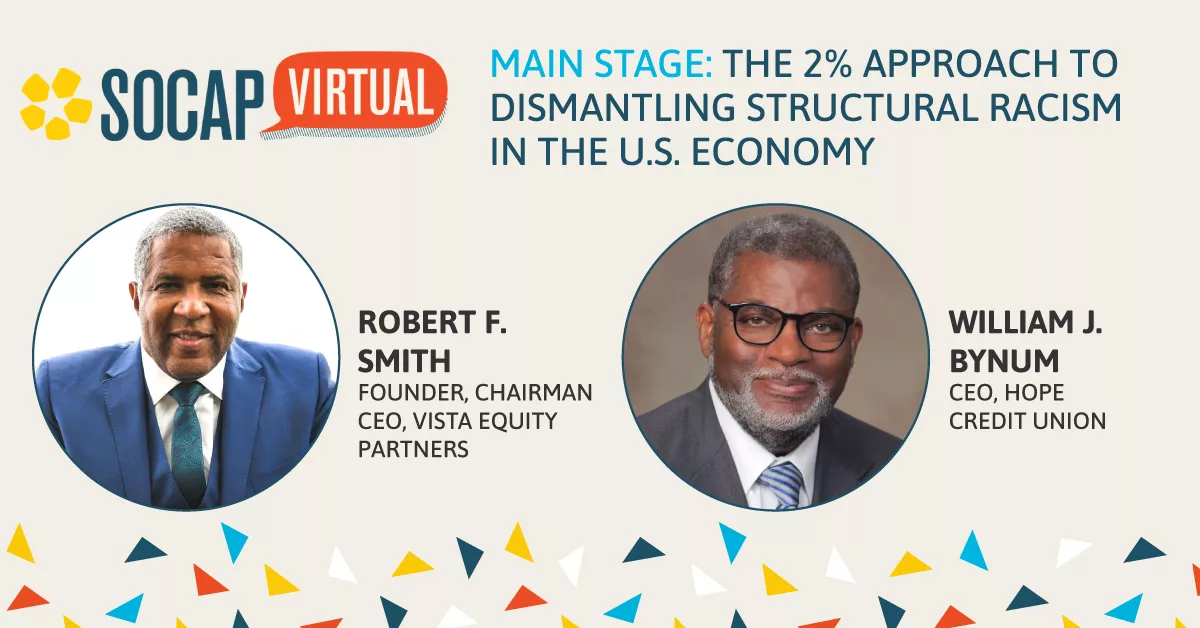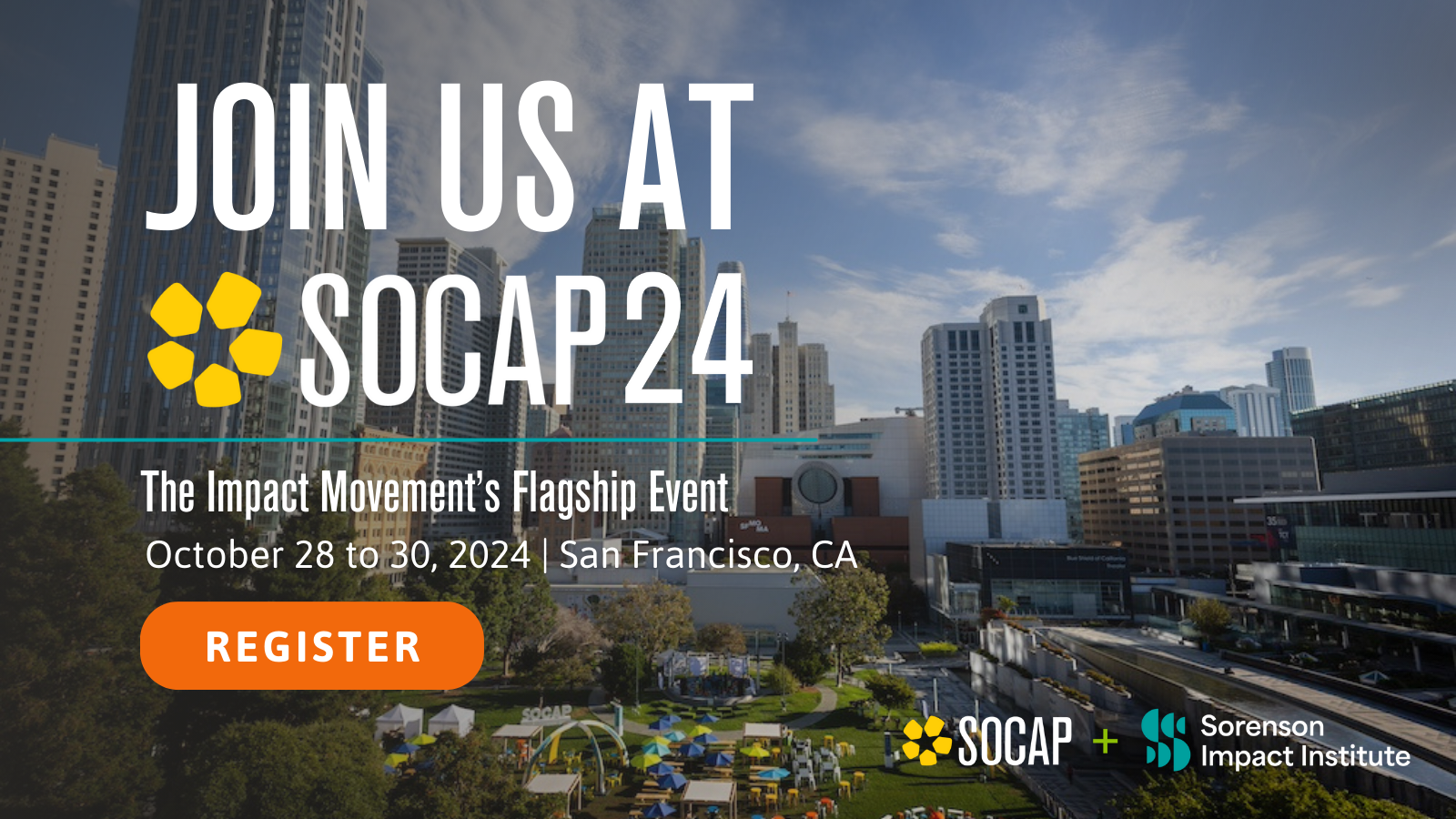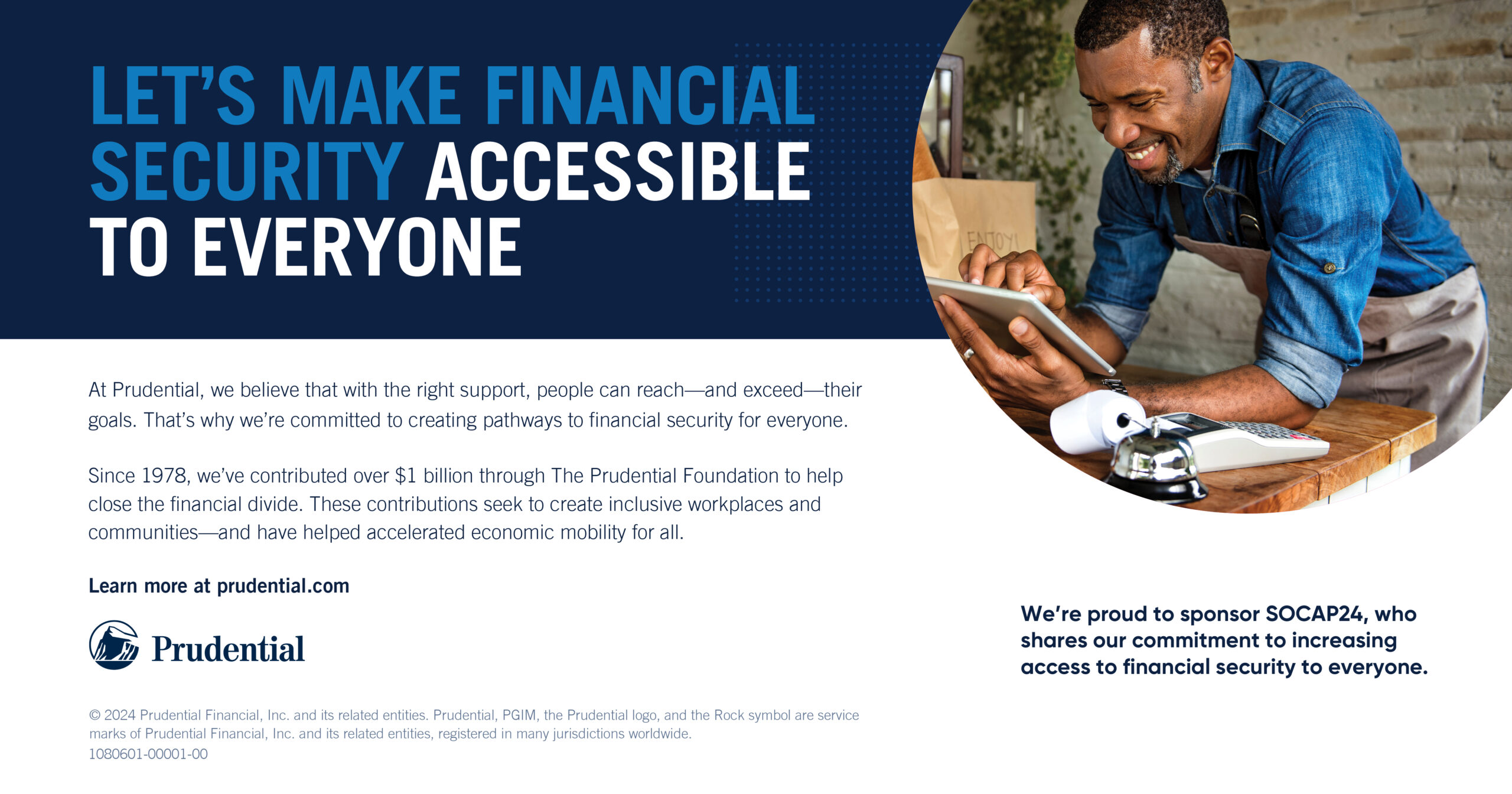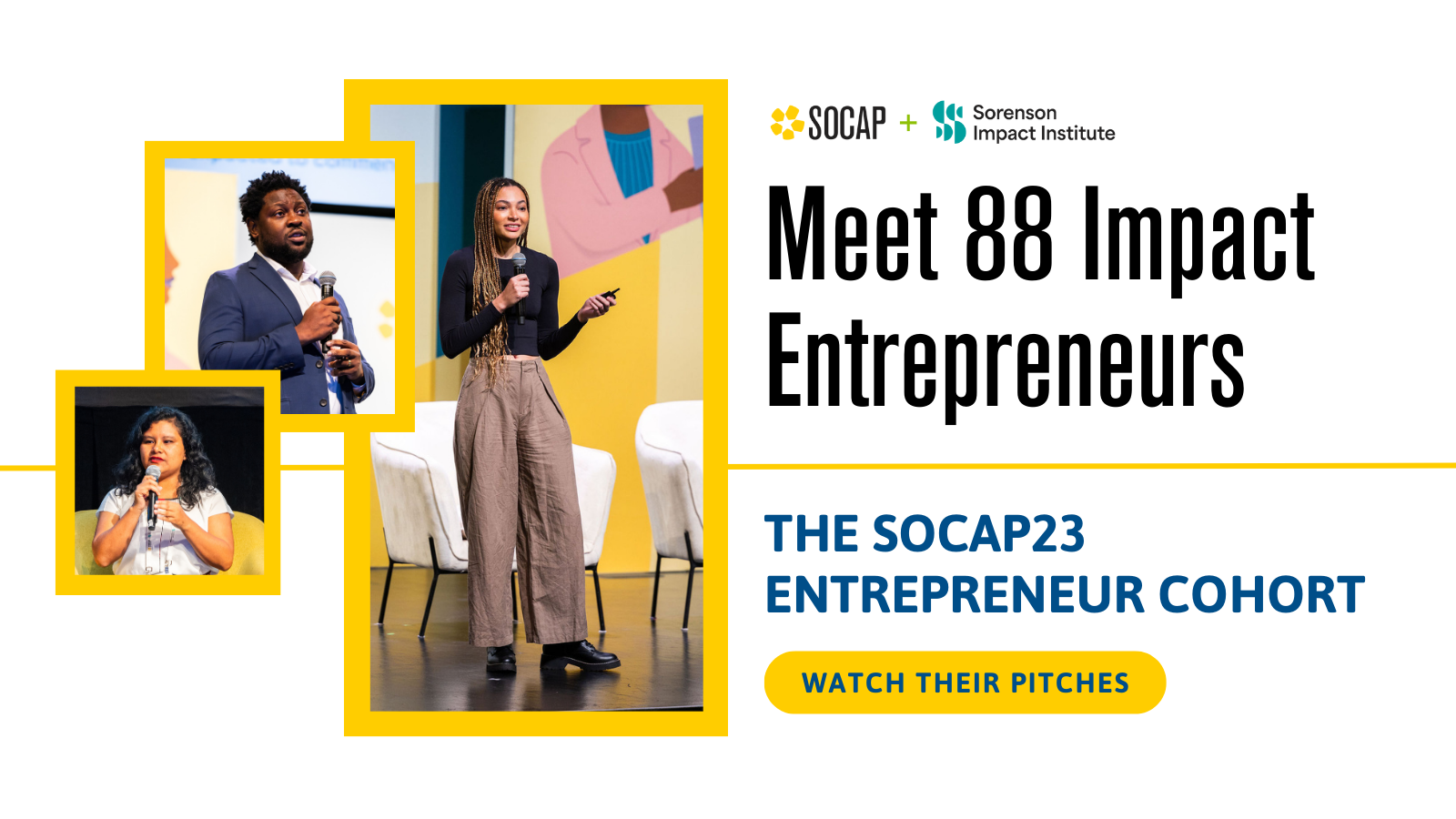How Big Banks and Large Corporations Could Invest 2% of Their Annual Profits to Reverse Structural Racism
Structural racism in the U.S. shows up in many ways, including as unequal access to capital and limited corporate or investment firm leadership positions for People of Color. It may seem hard to fully address structural racism, given its widespread infusion into our economy.
However, innovative solutions have been proposed, including the 2% solution proposed by Robert Smith, Chairman & CEO of Vista Equity Partners, which manages more than $58 billion and has a portfolio that includes more than 60 of the world’s top software companies. Smith, who was named one of the world’s 100 most influential people by Time, called on large corporations to invest 2% of their annual net income for the next decade to address structural racism in the U.S. economy.
In this SOCAP Virtual 20 Fireside Chat with Bill Bynum, CEO of HOPE, a Black-owned credit union in the Deep South, the two discuss how corporate America can engage in partnerships to increase economic mobility for the nation’s most vulnerable people and places. Watch the session or read the transcript below to learn how corporate and investment leaders are committing to reverse structural racism, what remains to be done, and how you can be part of the solution.
Watch the 2% Approach to Dismantling Structural Racism
William J. Bynum: I’ve had the privilege of working alongside you over the past few months, and was really inspired by the 2% Solution. The idea that the best way to begin to reverse corporate America’s history of structural racism is for large companies, for big banks, to invest 2% of their annual net income, over the next 10 years, in ways that empower minority communities. Really want to thank you for that bold challenge. And I’d like to get your sense from you of how this plan has been received so far. And let’s just start there. I’d be curious to see how much traction it has been getting.
Robert F. Smith: Yeah. It’s interesting. When you and I were working on the Paycheck Protection Plan activity, and I really started to understand, through your eyes and through other managers of our CDFIs and MDIs, our capital or banking system, the real challenges that you all face. And a big part of the challenge is the under capitalization, on the one hand, and the lack of modernization of the technologies to deliver comprehensive lending solutions, credit solutions, loan management solutions to the communities that you serve. And those are very vital communities, and frankly just under-capitalized. And in recognizing that, and as you and I and others spent time thinking about it, I said, “Look, a couple of things we need. First, we need capital delivered into this capillary banking system, point one. But second, we need to modernize.”
And so, bringing forward the idea, because I get to work in the intersection of technology and finance, I said, “Well, why can’t companies really bring forward A, capital, and B, wherewithal?” And we’ve been using some of our companies and the wherewithal to modernize this infrastructure. And we said, “Okay, well now how do we get capital?” And when I started looking at the very large banks and the amount of profits they made over the last 10 years, I said, “Man, if they dedicated 2% of their annual net income to these CDFs and MBIs, and driving capital and credit solutions into the communities, it would eliminate, I call it, a lot of the access to capital gaps, which ultimately creates safer communities, creates communities that are more robust, and ultimately eliminates a lot of the disparities of first income and wealth in these communities. And I think that would drive economic activity now forward pretty substantially.
In fact, we partnered with McKinsey, and some of Eric Smith’s folks, and some folks at Dell and Microsoft and others. As we started getting this work done, what we realized is if you actually, of course, eliminate this wealth disparity, you create about $1.5 to $2 trillion of GDP. So now the question is, how do you get that capital into the community? So one of my good friends was working with one of his partners at Bank of America, Anne Finucane, and they came up with an idea and it’s called the Equity Progress Sustainability Bond. This is a $2 billion bond.
It was two and a half times over subscribed. And in essence, it’s the first social inclusion bond by a bank. They issued $2 billion. In essence, it can be used for affordable housing, low-income tax credits, financing, supply chains, and putting in tier one/tier two capital into MBIs, and in grants and funding for CDFIs, et cetera. So, now they’ve done the first one, they’re lining up a number of Fortune 500 companies to issue similar bonds, to do the exact same thing. So, you can actually finance it using these bond structures, which are clearly in demand, based on how the commitments were subscribed to. And I’m actually quite excited about that, because now there’s a financing vehicle that we can use to really support this 2% initiative.
William J Bynum: That’s really encouraging. And it’s an indication that we’re actually seeing companies start to push the envelope a bit. Because while there’s been a spattering of investment over the years in underserved communities, you see that the numbers don’t change dramatically, where we’re not closing the gap. It’s really going to take a step further than we’ve seen historic movement to actually overcome centuries of underinvestment in communities of color.
Robert F. Smith: Right? And as you and I have talked, Bill, one of the most important things is to put the sustained levels of investment into the communities, across multiple dimensions, as opposed to a one-time shot of, “Oh, here’s a grant, one time.” You can issue these bonds literally every six months. And there’s a return to the investors. What Bank of America did in this case was they actually got minority banks to do the underwriting and be the agent. So, there’s money that went into those institutions. And now, you can actually sustain a capital infusion into the areas that most need it, education, welfare, health, eliminating some of the capital deserts that truly exist in our communities. So, I think about it as a very elegant solution to solving this problem. And you can do it for long periods of time, not just a one-time shot. And I think that’s what the key is.
William J. Bynum: Well, you mentioned earlier the work we did with the paycheck protection program, and the important role that, as you’ve so, I think, aptly termed capillary banking, the capillary banking system in closing these gaps, I’d be interested to get your perspective on how the initiative that Bank of America has launched can connect with those frontline first responder institutions that are more present in these communities. Because, as we know, banks control the vast level of resources that can help promote wealth, but they don’t have a great history of actually connecting those resources in communities of color and underserved high poverty places. So, I would hope we could make the linkage with CDFIs, minority depositories, as you’ve been working to strengthen that capillary banking system.
Robert F. Smith: Yeah. And I am seeing what I’ll call the connective tissue form, and now being strengthened. For instance, out of this work, the business round table convened a group to focus on a number of areas. And one of the areas that I got to co-lead with Jamie Diamond was focused on finance, our finance subcommittee. And out of that, we said, “Okay, what are the things we need to do to enable this capitalism banking system to be more effective?” And what’s come out of that is actually pretty, pretty impressive. First thing is an investment and provide technical assistance to Black-owned and run, and Latinx-owned and run businesses. How do you now start to drive ongoing mentorship, support? And I’ve got a group working with Satya and his team at Microsoft on, I’ll call it, Business in a Box. And the folks at PayPal and Square and others are saying, “Okay. Well, how do we deliver technology solutions for the 50,000-plus Black and Latino small business owners?”
And that’s our goal, 50,000 by 2025 that are enabling technologies. The average ROI, return on investment, of technology in the small-medium business is over 900%. So, it’s probably one of the best investments you can make. So, that’s kind of one. Two, we’ve made a goal to provide grants and low-cost debt to community development financial institutions, CDFIs, like you run. And we’ve set a goal of investing $1 billion dollars by 2025, and to invest in Tier 1 and Tier 2 capital and deposits $600 million by 2025. So these are all the BRT financial institutions, largest financial institutions in the US. And then, support pilot plans or programs to modernize the systems and infrastructure of the MBIs and CDFIs. We’ve got a number of companies who are coming up with, I’ll call it, the lender in a box solutions to deliver the modernization capabilities, so that you have the ability to deliver to your… well, us to the MBIs/CDFIs technical solutions, which can decrease the processing cost.
And you know it takes about seven and a half to eight hours without technology to really process loans effectively. And when you implement these solutions… I mean, you can do these things literally as you build your infrastructure in minutes or hours. And cost is reduced quite dramatically. And you can put more capital with more modernization. You can make a more efficient lending infrastructure, which will again drive massive income and then wealth creation and opportunity in these communities. And I think that’s what’s sustainable. And so, you’ve got not just the large banks, but the big Business Round Table, with the technical folks and technical companies all focused on these sort of solutions. And now, the next piece of course is how do we start to drive more policy decisions to start to support this more effectively? And so we’re, of course, continuing to work with administration, and congressmen and women, to support those efforts as well.
William J. Bynum: You take a very systems-based approach. You dissect these challenges and then rebuild them. And when you talk about the CDFI sector, I think it is really important. And you bring a great perspective to this conversation, because often conversations around CDFs and MBIs, particularly those in places like the ones I serve, the Mississippi Delta, the Black belt of Alabama, some of the poorest places in the nation. And there’s a narrative around lack of capacity. Well, it’s a lack of investment. And as you’ve seen, as we’ve seen, when you make those strategic investments, whether it is technology or capital, because you need both, you get incredible results. My organization went from making 40 to 50 business loans in a year to, within six months, processing 7,400 PPP loans, closing 3,000. But it took the strategic technology investments, as well as the capital.
Robert F. Smith: You take your numbers, 50 to 7,500 or 17,000. You start thinking about scaling out across all the CDFIs and MDIs, and building that capacity, and then driving capital through this channel. We’ve got 1.4 million small businesses as customers across our portfolio.
When you enable those small businesses to be more effective, they hire more people. They stabilize neighborhoods. They put more tax revenues back into those communities. And those communities self heal.
Robert F. Smith
And I think that’s how we should think about it. So, it’s great to hear from where we were six, eight months ago to where we are today with your group. It’s great.
William J. Bynum: I think we’re on the right path. You talk about the impact in communities on families, on children. And I know that’s been a big part of your life’s work. I’ve heard you talk about the importance of your high school internship experience at Bell Labs, and how that influenced your career path and then ultimately got you where you are today. Can you talk a little bit about why these opportunities, why internships, are so essential to creating a high qualified, diverse pipeline of talent?
Robert F. Smith: Sure. Where I grew up in Denver, Colorado is that I grew up at a time when computers were just getting introduced into the schools. And today, when you think about it, we have computer capacity that’s really available everywhere. The question is, do kids have access to it? And so, we’re working on solutions. We’ve got some partnerships that are becoming quite effective actually with the Business Round Table and others to say, “Okay. How do we actually deliver through these bonds, for instance, the last mile gap for students to gain access to computing capabilities?” We have to, as a country, unleash the capacity of our people. We have to unleash the capacity of our young people. And the best way to do that is give them access to computing, PowerPoint, number one, and then instruction, point number two.
And then the third thing, which is really the overlay of that, is mentorship. I had a great experience working at Bell Laboratories when I was 17 years old. And I had a mentor who was in his 60s. And the relationship of having a very senior person with experience, and an interest and a desire to give forward knowledge information is critical. And I credit him in particular with helping me discover the joy of figuring things out, which is, again, one of the things that I embrace as one of the tenants of a life well lived is enjoying solving complex problems in that context. And I think what we’ve been focused on now… We built the platform, InternX platform. We’ve got 12,000 or so African American students and Latinx students.
Of course, because of the way it’s built, we can kind of have hundreds of thousands, and then partnering those with companies. And beyond just, “Okay, here’s some students you can choose from,” you actually have to, as a company, go through modules of training in how to become a good mentor, and how to become a good supervisor for these, for these students, especially in today’s time when we have distance internships.
Which kind of gets back to the question. My parents were teachers and we had no real engineers in our community. So, what does an engineer do? And it wasn’t until I actually got a chance to see what an engineer does that it made me excited to pursue that as a career. And I think it’s important that we provide access and exposure, sustainable engagement, which is an easy thing to do in this digital world when we engage today, to give those kids a chance to ask the questions and hopefully discover the joy of figuring things out.
William J. Bynum: Oh, we really appreciate how you have paid it forward. And as you said, in addition to the exposure, there are real financial constraints that limit opportunity for communities of color, particularly our children. And as we’ve seen the enormous amount of debt on families, particularly in minority communities, rise, I’d like your thoughts on what can be done in terms of helping students overcome these obstacles. And you’ve made investments in HBCUs. I’m trying to find the Robert Smith for Mississippi Valley and Alcorn and others here in our region. But you clearly, as you wrote in on this as an important issue… But what are your thoughts about what can be done in terms of helping students at HBCUs with student debt?
Robert F. Smith: Sure. As I made the gift at Morehouse, I really realized the challenge that a lot of our students have. A, they come out of school with a little more debt, about $7,500 more. And then unfortunately, because of the income gap and wealth gap, either parents typically don’t have assets, houses or financial assets that they can pay college, these kids end up borrowing more and having more to pay back five and eight and 10 years later. And it’s debilitating. And the most shocking statistic that we learned in this work is over 60% of African-American wealth goes towards servicing student debt, student loan debt, which is just appalling. And when you think about it, most of that capital goes, for the most part, back to the federal government, because a lot of them are federal loans, parent plus loans, et cetera.
And African-Americans traditionally haven’t participated in some of the other wealth acquiring mechanisms that the federal government has provided over time, Homestead Act, GI Bill, those sorts of things. And so they don’t have the general generational wealth to support that next generation of engaging in the uplift. And most people know that a college education has traditionally been the biggest uplift, from a wealth perspective, in America. But if you’re burdened with this debt, it’s just almost impossible to overcome in a reasonable period of time. So, what we’ve now done is we launched, about a month ago, I think called SFI, Student Freedom Initiative. We’re doing our first launch with 11 HBCUs. We’ve funded it with the foundation of $50 million. And in essence, what we’re able to do is take in the whole idea of paying it forward, take this capital. Students can borrow it.
It’s a lower price than loans. But they don’t pay it back to the government or an institution. They pay it back into the fund. And if you go and you work at a tech company or a financial institution, whatever, you’re making more money, you pay back a little faster, a little bit more. And if you go teach at a school in your community, you pay back a lot less for a lot longer. But it fuels the system that then gets to fund the next generations of kids. So now, with that initial funding, we will be able to graduate STEM students out of those 11 HBCUs, in perpetuity, which is phenomenal. And as we raise the additional $450 million, we’ll be able to support all STEM students out of all HBCUs, in perpetuity.
And I think that is, again, a unique solution. I’m excited about that because it gives these kids, these students who become adults, a chance to actually build wealth, get a college education, not have the burdensome debt. They will have debt, but not so burdensome that they can’t build wealth. And it gives them some flexibility to not just go work at a job that pays a salary, but potentially go and become a teacher and drive that STEM education back into the communities very directly. So, that’s why I’m excited about what this initiative is.
William J. Bynum: That’s really exciting. And those numbers are encouraging, particularly as we see the country becoming more Black and Brown. We cannot afford to leave so many assets underdeveloped. And I think that’s what we’ve done too often with our children, particularly children of color, which takes me to the work you’re doing at the Business Round Table. I’m really encouraged by the restated purpose of a corporation, an economy that works for all Americans. I think that’s important. And, as you work with this group of CEOs to promote a thriving economy and expanded opportunity, I know that you have been leading in efforts around this racial equity agenda. Can you share some of how that’s developing, and how it addresses racial disparities under leadership of the business sector?
Robert F. Smith: So Doug McClellan, over at Walmart, kind of at the heels of the George Floyd murder said, “Listen. We need to understand what is going on and do something about it.” So, he formed a series of subcommittees. One is the equitable justice subcommittee. Originally, Randall Stephenson was chairing that, and now we have Craig Arnold who’s at Eaton Corporation chairing that group. We have a health subcommittee. Arnie Sorenson, who runs Marriott, is chairing that group, Jamie Diamond and I are on the finance committee. And then, we have Mary Barra, of course, from General Motors, who’s education and workforce subcommittee. And there’s two big categories that we focused on. And we actually just formed a broadband committee because it’s cutting across all of them. One is, what can we do as corporate leaders that have access to the assets of the corporation, people, hiring, training, et cetera?
And then, the other piece is, what can we support from a policy perspective to advance racial equity, social justice, et cetera, economic justice? And so, we’ve actually just finished the reports from each of these subcommittees. And I think there’s easily over 150 CEOs that got involved in this. And, like I said, with real tangible goals for things that we can do, and then tangible objectives in terms of things that we can support, as it relates to pushing forward through the government… What are the steps that government can take and how can we encourage them to take these steps? And so, I would encourage everyone to get a copy of this report. And Bill, I’ll get a copy to you because, again, it points to some very specific things that we can do as companies, and also initiatives that government, through our support… Irrespective of where you might sit politically, it just makes sense for our citizenry to be the most effective citizenry.
And like we talked about, if you really eliminate the wealth disparity in this country, not only does it expand our GDP by up to 7% per year, but there’s studies, plenty of studies, that show that when you actually have communities that are economically viable, they are safer communities. And when they’re safer communities, you have the ability to support more wholesome lifestyles across the board. So, we can eliminate these capital deserts, these education deserts, healthcare deserts, food deserts, through these sort of initiatives. And I think it’s incumbent upon the large corporations, which I’m so proud and pleased that the BRT has adopted this as an area that we are going to put true attention and focus on. And then, in addition to the things we’re focused on we’re seeing how it relates to climate change, because I think we have to do that all in the construct of preserving our planet, the home which we all live in.
William J. Bynum: What you said really connects with me. We were started here at Hope by Rob Walton, Sam Walton’s son, who recognized that his interests align with the faith of the people in the communities, where they live and work, and where they rely on to buy their products. And I think that alignment between our interests is the only way that we can really get through and… these challenges, and get collective action at the level that’s needed. And so, I really love your perspective as we wrap down. Are you optimistic? Do you see the corporate community using their position to, as you said, influence policy, but also their own practices to close these gaps in a way that will actually get us to that more perfect union?
Robert F. Smith: So, when I think about it, am I optimistic? Generally, yes. I see the work that’s happening at the BRT, and I’m optimistic about that. I don’t know if you know Treasurer Wooten in Connecticut. He has convened a group of investors. And these are the largest investors in the world. These are public market investors, from the BlackRocks, Alliance, Bernstein, all those sort of firms. And he has challenged them along the same lines and saying, “You bring your heft and your power as investors to these corporations and say, ‘Here’s what we want from you.'”
I liked the way he thinks about it. There’s a mirror and a window. Okay. The first thing in the mirror, what are you doing internally, promoting equitable opportunities within the corporations in which you run? And what are you doing through the window in supporting as an investor initiatives that you know make sense for the corporations that you are the shareholders of?
When I think about the corporations, when I think about the shareholders, I think about the employees that make up the community. Then, I think about the broader community of teachers, and firefighters, and healthcare workers, police officers, etc. And then, you have government. This is the first time I’ve heard all of those constituencies really start to say, “We need a change.” In some cases you would see groups say, “We need to make a change.” And others would say, “I understand, but I have a priority that I need to go deal with.” This is the first time I’m hearing the priorities being aligned across all of those groups. And that’s what gives me optimism. That’s what gives me hope.
William J. Bynum: Robert, what would you say to these thousands of investors who are watching this conversation today? What is the challenge? What is something you would charge them to do to use their position, to make a difference?
Robert F. Smith: Yeah, I think first look in the mirror and say, “What can I do with things that I can control, hiring, training, promotion, implicit bias? I’ll eliminate all of that in my organization as best I can.” But don’t wait to just do that. Look through the window and say, “Here are the organizations that are being effective.” BRT is a good place to start because we’re pointing to, okay, you want to get involved in fair housing, you know nothing about it? Here are organizations that can help. You want to get involved in the Student Freedom Initiative? Here’s an organization that can do it. So then, be very conscious and look out the window. And look at organizations that are doing things and invest in them. We pulled together, for instance, a list of 13,000 school districts and what students don’t have access to broadband.
I’m happy to give you the list. And then you can look into the community and say, “You know what? These students may not have broadband, or they may have broadband and don’t have a device. Let me get involved”. And Michael Dell’s got his team involved on that for community. So people actually saying, “What can I do to help?” Safya got his team involved in finding ways to deliver services at a low cost to these communities? We’re delivering the learning management systems through our company. Look for those companies, those groups, those organizations, those institutions that already have the elegant solutions outlined, and put heft behind them, put capital behind them, put time and resources. I tell my teams all the time, “We can always write checks, but often it’s our organizational capacity and writing checks that makes a sustainable difference.” And I think that’s what we’re seeing is a lot of brilliant people focused on bringing a new set of organizational capacity to find the right new equilibrium of inclusion in our economy.







